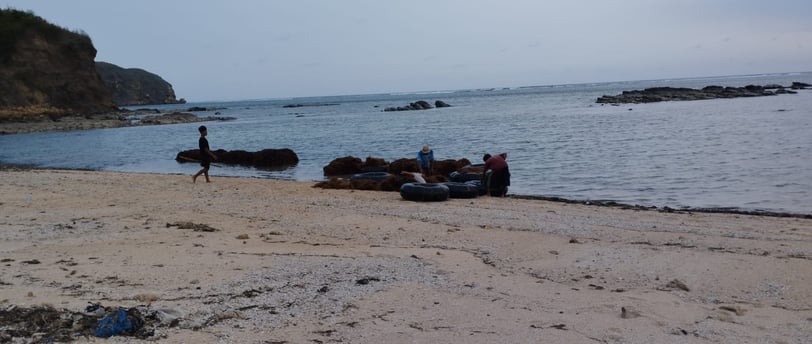Seaweed Farming in Indonesia: The Growth and Potential of Eucheuma Cottonii
Deskripsi pIndonesia's seaweed farming sector sits at the nexus of environmental sustainability and commercial possibility.
Syafrizal
4/21/20253 min read


Seaweed Farming in Indonesia: The Growth and Potential of Eucheuma Cottonii - Indonesia, as the world’s largest archipelagic country with over 17,000 islands, tactically positions its marine industries given its second-longest coastline. Seaweed farming is known to be a high-value sector among all oceanic assets. Eucheuma cottonii farming is especially prominent in that area. Carrageenan, a widely used natural thickener, is sourced from that red seaweed species, and also it aids sustainable coastal livelihoods.
Across Indonesia’s eastern provinces, such as South Sulawesi, East Nusa Tenggara, as well as parts of Kalimantan, the Eucheuma cottonii seaweed truly thrives. Its overall commercial viability and relatively brief growing period make this seaweed attractive for common cultivation. It is usually ready enough for harvest within those 45 days; if conditions are ideal, it is also a renewable, reliable income source.
In addition to carrageenan, studies have shown β-carotene, a natural antioxidant present in Eucheuma cottonii, can serve as a viable substitute for synthetic artificial color stretchers in ornamental fish (e.g., koi) aquafarming. This method not only supports the natural colouration of fish but also decreases the risk of environmental contamination resulted from synthetic food additives (Jurnal Tropimar, Hang Tuah University, 2021).
Cultivation of Eucheuma cottonii, however, only limited range of area for growing as it is highly constrained by environmental factor. Preferred growth conditions are good, including clear waters, moderate currents (20–40 cm/sec), salinity 30–37 ppt, and stable temperature (27–28°C), the cultivation area should be clean, should not be polluted by the industry and the river, but also should have enough sunlight and gentle wave movement. Some of the best farming zones are found in shallow waters near coral reefs, where the seabed is stable and not overly muddy (Seaweednetwork.id, 2023).
Depending on local conditions, Indonesia employs three main farming techniques: the off-bottom method, the floating raft system, and the longline approach. Shallow waters with sandy or muddy seabed are typically used with the off-bottom technique. Under this approach, seaweed seedlings are fastened to ropes strung between wooden posts buried on the seafloor.
Baca juga: Eucheuma Cottonii Seaweed Specifications
Seaweed Farming in Indonesia: The Growth and Potential of Eucheuma Cottonii
In deeper or rougher waves, the raft technique—which entails hanging the ropes under bamboo or wooden rafts—is used. Still, the most often used technique is the longline system, in which floats suspend ropes horizontally. This system produces premium seaweed (Cybex, Ministry of Agriculture, 2022), is reasonably affordable and straightforward to run.
Once grown, the seaweed needs little but continuous maintenance. Farmers routinely replace injured seedlings, wash the ropes of any dirt or epiphytes, and check for disease—especially the "ice-ice" syndrome, a common problem brought on by sudden variations in water quality and temperature. Many farmers are now taught to find sites with more consistent marine conditions and to choose hardy seedlings in order to lower their risk of this disease (Seaweednetwork.id, 2023).
Economically, growing Eucheuma cottonii has proved successful. Longline seaweed farming in Bone, South Sulawesi provides a Return to Cost Ratio (R/C Ratio) of 2.0, meaning that for every 1 million IDR invested, a farmer might possibly earn 2 million IDR in return. Given the projected 1.7 year average payback period, this project appeals particularly in coastal regions where employment opportunities are few (e-Journal Balitbang KKP, 2023).
Though promising, difficulties still exist. The sustainability of seaweed farming may be influenced by environmental changes, lack of availability to quality seedlings, market price swings, and limited post-harvest processing facilities. Many government initiatives and NGOs have responded to these issues by providing training, upgrading infrastructure, and matching farmers to local and export markets. Particularly from the food and pharmaceutical sectors, Indonesia's position as a seaweed powerhouse becomes increasingly important as the worldwide demand for carrageenan keeps rising.
Particularly for Eucheuma cottonii, Indonesia's seaweed farming sector sits at the nexus of environmental sustainability and commercial possibility. Apart from empowering coastal towns, the industry helps worldwide businesses looking for natural, biodegradable materials. With the correct support mechanisms, regular quality control, and market access, Eucheuma cottonii farming in Indonesia appears to have bright future.
Now is a great time for coastal dwellers thinking in entering the seaweed business, investors, or entrepreneurs to investigate the possibilities of Eucheuma cottonii. This little seaweed might be the next major wave in Indonesia's blue economy given short crop cycles, worldwide demand, and sustainable farming methods - Seaweed Farming in Indonesia: The Growth and Potential of Eucheuma Cottonii.
PT. KYKYS BAROKAH ALAM
Supplying premium Eucheuma Cottonii from the pristine coasts of Indonesia to meet the diverse needs of industries worldwide.
Contact US
INQUIRIES
© 2025. All rights reserved.
